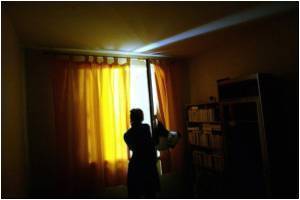Beauty, they say, is all in the eye of the beholder

But the new show at the Imperial Furniture Collection isn't really about napkins. And to be honest, it isn't really an exhibit either, says the artist behind it, more of a life-sized research project.
Joan Sallas, 47, a Catalan master of folding techniques, spent three months folding 200 metres (656 feet) of linen into more than 100 objects for the show.
All are copies of 16th- and 17th-century originals, but his only guides were old engravings and documents describing imperial and royal banquets.
So his work was akin to deciphering a coded message, Sallas explained at a preview of the show, which opened Wednesday and runs until January 23.
"This isn't an exhibit, it's a research project in the form of an exhibit," he said jovially. "The heart is not the objects that are here on display but the research, which evolves dynamically."
Advertisement
Supported by a wooden structure, a towering eagle and lion rear up against an intricate pagoda, to form a four-metre-long table-top display.
Advertisement
These were used as table decorations at major banquet functions.
"It's a luxury art that was practised at the table of every European court and there are so many different forms because the courts competed over who had the most beautifully dressed table," Ilsebill Barta, scientific consultant at the Imperial Furniture Collection, told AFP.
The art of folding paper and fabric goes back centuries -- the first recorded use of folded napkins in Europe was in 1529 -- and did not originate in Asia as commonly believed.
But this tradition has all but disappeared.
"I am very happy that we can spread this knowledge here, because it has actually been completely lost: Mr Sallas has revived it," noted Barta.
There are eight folding techniques -- including fans, rolls and lilies -- which Sallas used as keys to decode the historic works.
With linen specially commissioned from a former supplier of the Austrian imperial court, he created a ship in full sail, snowy mountain peaks and Renaissance-style headpieces.
"My favourite piece is always the one I haven't deciphered yet, the one I don't know how to fold yet," he told AFP.
"It is incredibly exciting for a researcher to investigate how an object was folded: you can sit there for days and nights, until you understand how an object was folded."
Sallas, who is also a cartoonist and makes his own folded creations, learned to fold paper from his grandfather as a child, and the passion stayed with him.
He now teaches in prisons and schools, believing that folding paper and fabric can be therapeutic, and he will give regular workshops at the museum.
One of the only masters of his art, Sallas has amassed some 2,000 books and documents in a private collection to make sure this knowledge is not lost.
But he has no difficulty letting go of his own creations and after the exhibit ends, "they're going into the bin," he said with a twinkle in his eye.
"This ephemeral quality is part of life," he added philosophically.
"We are only here for a short time."
Source-AFP








